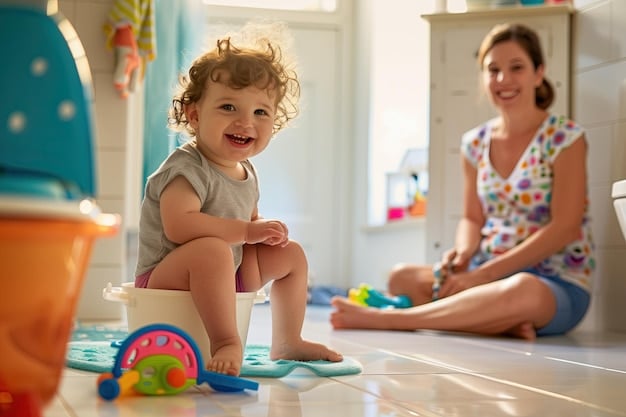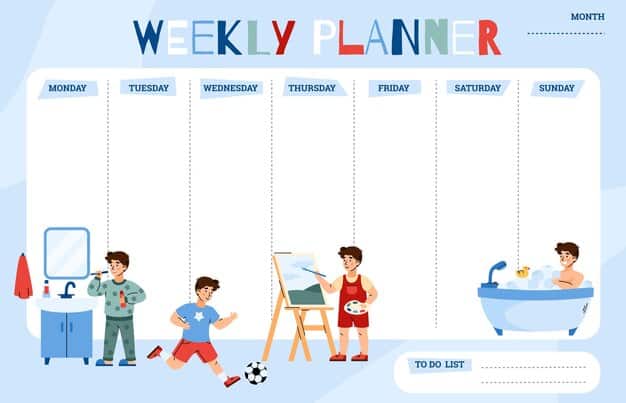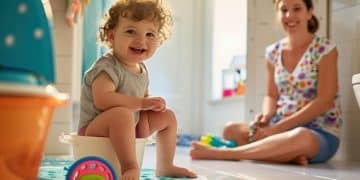Potty Training in 3 Days: A Quick & Effective Guide

Potty Training Power-Up: The 3-Day Intensive Method offers a structured, quick approach to help parents achieve faster and more successful results in toilet training their children, turning a potentially stressful time into a manageable milestone.
Struggling with potty training? Discover the Potty Training Power-Up: The 3-Day Intensive Method, a game-changing strategy designed to help you achieve faster, more effective results. Say goodbye to endless accidents and hello to confident, independent toddlers!
Understanding the 3-Day Potty Training Method
The 3-day potty training method is an intensive approach that promises to help your child become 90% potty trained in just three days. This method requires dedication and consistency but can be incredibly effective for families looking for quick results. Success relies on creating a focused, supportive environment where your child can learn and practice new skills.
The Core Principles
At the heart of the 3-day method are a few key principles: readiness, consistency, and positive reinforcement. Your child needs to be developmentally ready, you must commit to consistent training over three days, and you should provide plenty of encouragement and rewards.
Debunking the myths
One common myth is that the 3-day method is stressful for children. However, when done correctly, it can be a positive experience filled with praise and celebrations. It’s also not a one-size-fits-all solution; some children may need more or less time depending on their individual needs.
- Readiness is key; ensure your child shows signs of interest in using the toilet.
- Consistency means sticking to the plan without deviations for the entire three days.
- Positive reinforcement helps motivate your child and make the process enjoyable.
In conclusion, the 3-day potty training method provides a structured and focused approach to toilet training, offering a potential solution for parents seeking quicker results with the proper preparation and mindset.
Is Your Child Ready for the 3-Day Challenge?
Before diving into the 3-day potty training method, it’s crucial to assess whether your child is truly ready. Starting too early can lead to frustration for both you and your child, potentially delaying the process even further.

Readiness isn’t just about age; it’s about recognizing specific behavioral and developmental signs.
Key Signs of Readiness
Look for signs such as staying dry for longer periods (at least 2 hours), showing curiosity about the toilet, expressing discomfort in a soiled diaper, and the ability to follow simple instructions. These indicators suggest that your child has the necessary physical and cognitive skills.
The “Wait and See” Approach
If you’re unsure, it’s better to adopt a “wait and see” approach. Introducing the potty chair and talking about it without pressure can help gauge your child’s interest and readiness. Trying again in a few weeks or months might yield better results if they’re not quite ready now.
- Does your child communicate when they need to go?
- Can your child pull their pants up and down independently?
- Are they interested in watching you or other family members use the toilet?
Assessing your child’s readiness is vital before starting the 3-day potty training method, ensuring a positive and successful experience by watching for key signs and understanding that waiting might be the best strategy for some children.
Prepping for Potty Training Success
Successful implementation of the 3-day potty training method isn’t just about the three days themselves; it’s about the preparation you do beforehand. Setting the stage properly can significantly increase your chances of success.
Essential Supplies
Gather all the essential supplies: a potty chair (or toilet seat adapter), plenty of comfortable training pants, wipes, antibacterial spray, a waterproof mat for furniture protection, books or videos about potty training, and a reward system that motivates your child.
Creating a Potty-Positive Environment
Make the bathroom inviting with fun decorations, books, and even a step stool if needed. Talk positively about using the potty and explain the process in simple terms. Familiarizing your child with the concept ahead of time can ease any anxiety.
- Choose a potty chair that’s stable and comfortable for your child.
- Stock up on books and videos that make potty training fun and relatable.
- Prepare a reward chart with stickers or small prizes to celebrate successes.
Thorough preparation, from gathering supplies to creating a positive environment, sets the stage for a more successful 3-day potty training experience and reduces potential stress for both you and your child.
The 3-Day Potty Training Schedule: A Detailed Breakdown
The 3-day potty training method relies on a structured schedule to create consistency and reinforce new habits. This detailed breakdown will guide you through each day, ensuring you stay on track.

Day 1: Immersion and Observation
Day 1 is all about immersion. Spend the day at home, preferably naked from the waist down (or in training pants). Offer fluids frequently and watch for signs that your child needs to pee. Prompt them to sit on the potty every 20-30 minutes.
Days 2 and 3: Reinforcement and Independence
Days 2 and 3 focus on reinforcing the routine and encouraging independence. Continue with frequent potty breaks, but start encouraging your child to recognize and communicate their needs. Gradually extend the intervals between prompted potty breaks as they become more aware of their body signals.
Troubleshooting Common Issues
Address any accidents calmly and positively. Avoid scolding; instead, remind your child to tell you when they need to go. Celebrate every success with praise and rewards. If your child resists, try making potty time more engaging with books or songs.
- Offer plenty of water and juice to increase opportunities for practice.
- Use timers to remind your child (and you) about regular potty breaks.
- Stay patient and positive, even if accidents happen.
Adhering to a detailed schedule allows for consistency and reinforcement throughout the 3-day potty training process, turning it into a structured learning experience that promotes success and minimizes setbacks.
Positive Reinforcement: Making Potty Training Fun
Positive reinforcement is a crucial element of the 3-day potty training method. Creating a fun and rewarding environment can significantly boost your child’s motivation and willingness to participate.
Choosing the Right Rewards
Select rewards that genuinely excite your child, whether it’s stickers, small toys, extra playtime, or special privileges. Tailor the rewards to their interests and preferences.
Verbal Praises and Celebrations
Don’t underestimate the power of verbal praise. Celebratory words, high-fives, and enthusiastic smiles can be incredibly motivating for your child. Make them feel proud of their achievements.
- Create a reward chart where your child can track their successes with stickers.
- Offer immediate rewards after each successful potty visit to reinforce the behavior.
- Make potty time a fun, stress-free experience with engaging activities.
Employing positive reinforcement techniques, such as selecting appropriate rewards and offering enthusiastic praise, is essential for making potty training an enjoyable and effective experience for both parents and children.
Navigating Challenges and Setbacks
Even with the best preparation, challenges and setbacks are a normal part of the potty training journey. Knowing how to navigate these hurdles is essential for maintaining a positive attitude and continuing progress.
Dealing with Accidents
Accidents are inevitable. When they happen, stay calm and reassure your child that it’s okay. Clean up the mess without scolding and gently remind them to try to use the potty next time. Focus on the progress they’ve made rather than the accidents.
Addressing Resistance
If your child resists using the potty, try to understand the reason behind their reluctance. Are they scared, uncomfortable, or simply not ready? Adjust your approach accordingly, perhaps by making potty time more fun or revisiting the readiness checklist.
Adjusting the Method if Needed
The 3-day method isn’t set in stone. If you find that your child is struggling, don’t hesitate to adjust the pace or take breaks. It’s okay to modify the approach to better suit your child’s individual needs and temperament.
- Maintain a consistent and patient approach, even during challenging times.
- Offer encouragement and reassurance to keep your child motivated.
- Remember that every child learns at their own pace.
Effective navigation of challenges and setbacks requires patience, adaptability, and understanding, allowing parents to adjust their approach, offer reassurance, and maintain a positive environment throughout the potty training process.
| Key Point | Brief Description |
|---|---|
| ✅ Readiness | Ensure your child shows signs like expressing discomfort in soiled diapers. |
| 🗓️ Consistency | Stick to the training plan for all three days without deviations. |
| 🌟 Positive Reinforcement | Motivate your child with praise and small rewards for successes. |
| ⏰ Schedule | Follow a structured schedule with frequent potty breaks to build new habits. |
Frequently Asked Questions
▼
The 3-day method works best for children who are showing signs of readiness, such as expressing interest in the toilet or staying dry for longer periods. It may not be suitable for children who are not yet developmentally ready.
▼
Accidents are normal. Stay calm, avoid scolding, and gently remind your child to tell you when they need to go. Focus on progress rather than perfection, and adjust the frequency of potty breaks if needed.
▼
Nighttime potty training often takes longer than daytime training. Limit fluids before bedtime, ensure a potty trip before sleep, and use a waterproof mattress protector. Patience and consistency are key, as some children take longer to develop bladder control at night.
▼
Effective rewards vary by child but typically include stickers, small toys, extra playtime, or verbal praise. Choose rewards that genuinely motivate your child and offer them immediately after successful potty visits to reinforce the behavior.
▼
If your child refuses to sit on the potty, avoid forcing them. Instead, make potty time more inviting with books or songs and offer gentle encouragement. If resistance persists, take a break and try again later, revisiting the readiness checklist.
Conclusion
The Potty Training Power-Up: The 3-Day Intensive Method can be a transformative experience for both you and your child. By understanding the core principles, preparing effectively, and staying patient and positive, you can navigate this milestone with confidence and celebrate the independence your child gains.





